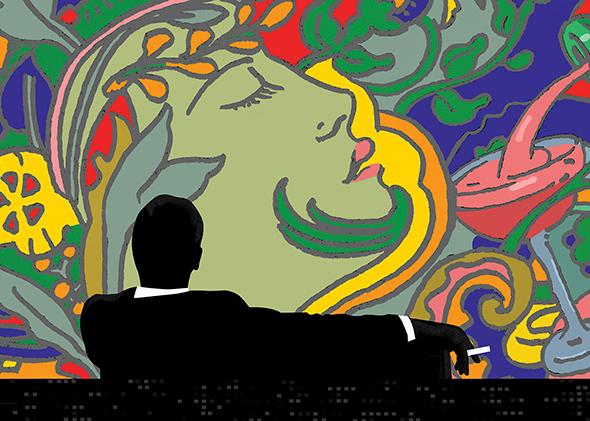Willa, Julia,
Slog is the right word, Willa, for the journey we went on with Don last season. We slogged our way through his infidelities, his drinking, his professional lassitude. And this time the thrill was gone. Exploits that once seemed louche and sophisticated curdled into something pitiable and childish.
In the end, even Don grew tired of Don. He begged those Hershey execs not to make little kids listen to “someone like me.” When he told Megan, “I don’t want to be here anymore,” yes, he was talking about fleeing to California—but, given the utter capitulation in his voice, it felt more like Don was telling us he didn’t want to be here on this earth anymore. As though he wished he could, much like the protagonist of his proposed Royal Hawaiian ad campaign, amble into the ocean and disappear forever.
What a relief when, in the final scene of last season, it appeared that Don had finally found some inner peace—that trip to his childhood home was his way of coming clean to his kids, and in a way himself, about the squalor and indignity that haunt his past. I really couldn’t have slogged through much more of his angst . For me, the expectation-thwarting Weinerian chess move at this juncture would be to switch protagonists completely. Don has brought us just about as far as he can go. Let’s allow him to recede a bit, get fat and happy. Visit an ashram or maybe coach Bobby’s Little League team. I’m OK with turning this into Peggy’s show. Sally’s, too.
Willa, you mentioned the puzzle-solving impulses that ran rife among Mad Men’s fan base last year. Those convoluted theories and bank-shot prognostications did sometimes feel more suited to an escapist fantasy like Lost than to a show that wants to turn a microscope on America’s mid-century societal convulsions. Still, Matthew Weiner bears blame for encouraging our behavior. Mad Men is hyper-literary in its storytelling—reliant on foreshadowing and symbolism and heavy-handed Dante references. Nothing, from the set design to the wardrobe choices to the teensiest snatches of dialogue, is unplanned or unconsidered. Who can fault us for convincing ourselves that we can ferret out clues and find answers?
Just look at last year’s poster art, in which two Dons pass each other in the street. The season indeed hinged on doppelgangers and moments of Jungian duality. Episode titles like “The Better Half” gave the game away, as did cute devices like casting Megan as a pair of identical twins on her soap opera. There was the alliterative Bob Benson as a new Don Draper, another handsome fellow with a forged past and ruthless ambition. The oppositely charged poles of New York and Los Angeles, with Don, Ted, Stan, and Pete all ricocheting—or begging to ricochet—from one to the other. And, ultimately, the grand arc we witnessed was Don’s attempt to reconcile the two conflicting halves of himself.
So what can we glean from this year’s poster? The art is by the design legend Milton Glaser, who created this similarly psychedelic Bob Dylan imagery. Are we to infer—looking at that same old silhouette, still glued to the same couch it’s been reclining on since Season 1, dangling the same cigarette—that Don will remain an onlooker as the Dionysian late ‘60s unfold before him? Observing the colorful swirl, but not of it? Don would be about 43 in 1969. Is he too old to grow out his sideburns? To admit defeat, ditch his hat, and slip on some corduroys and a fringed jacket?
Given that Season 1 began and ended in 1960, I’ll go ahead and wager that Season 7 will take place entirely in 1969. Seems like a fitting bookend, making this a show that’s as much about a decade as a collection of characters. So, what’s coming up on our calendar? I imagine Stonewall, Chappaquiddick, the moon landing, and Woodstock might make appearances in these first seven episodes, along with those Tate/LaBianca murders. When the final seven episodes of the series air in 2015, I’m taking a wild guess that they’ll conclude in December, 1969, with Altamont—infamously considered “the end of the ‘60s.” (For some reason, I can imagine former Hare Krishna and sci-fi auteur Paul Kinsey reemerging as an embittered, hollowed-out Hell’s Angel.)
Whatever happens, I’m looking forward to chewing it all over with you two. Willa, I’m also Team Steggy. How about you, Julia? Holding out for Pegsberg?
